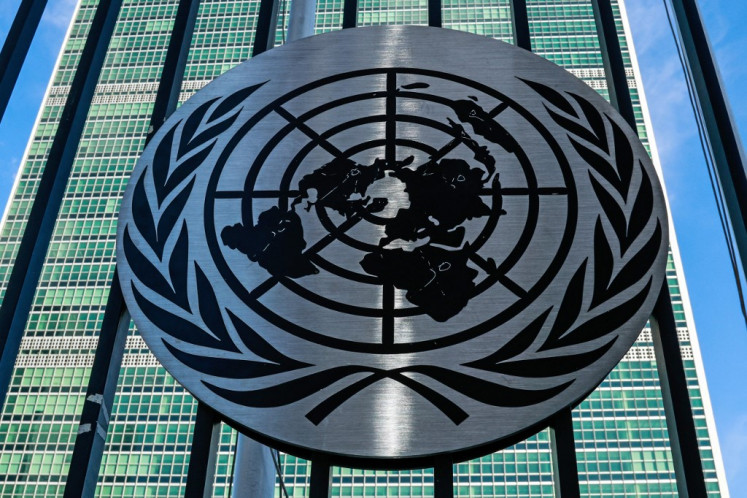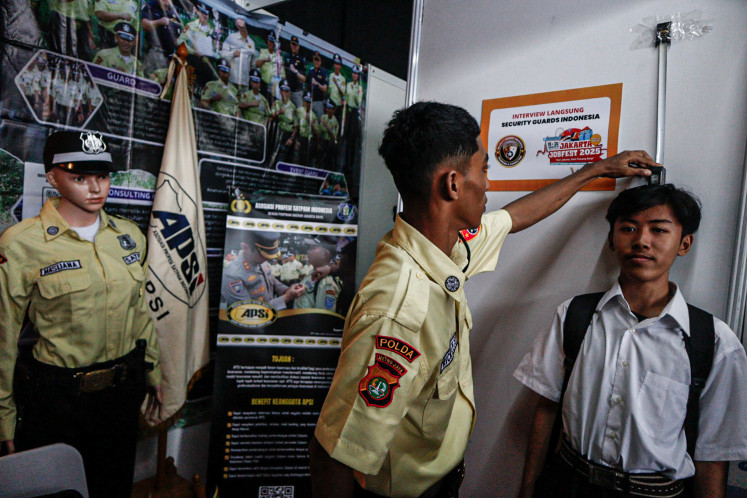Popular Reads
Top Results
Can't find what you're looking for?
View all search resultsPopular Reads
Top Results
Can't find what you're looking for?
View all search resultsDoes dress determine faith?
A daughter who had suddenly turned religious asked her elderly Sundanese mother to “cover up”
Change text size
Gift Premium Articles
to Anyone
A daughter who had suddenly turned religious asked her elderly Sundanese mother to “cover up”. She said: “Mak ayi geus kolot, nganggo acuk tong calawak teuing, era ka incu”. If we translate this statement into English, it roughly means: “Mother, you’re old, you have to be modest in front of your grandchildren, don’t show your skin too much”.
You wonder what this elderly woman wore that made her daughter ask her to dress more decently. Just like many women of her generation at that time, she wore a traditional, tight-fitting body kebaya brokat. What made her daughter the most irritated was the kebaya brokat that this elderly woman used to wear, a low cutting cloth that reveals a little bit of cleavage.
On special occasions, this elderly woman often became an object of teasing from her then jilbab-wearing relatives. She was teased not only because she wore kebaya brokat, which was transparently showed her skin, but because she wore a gold necklace which pointed straight to her cleavage, and kelom geulis (Sundanese traditional sandals), which exposed her feet and nails, which were varnished so that they matched the color of her kelom geulis.
One word which was used to tease her, was the same word used recently by the Governor of West Java, Ahmad Heryawan, when he criticized the traditional dress of Jaipong dancers, which he considers obscene.
The word is lekbong (kelek bolong), which refers to clothing that shows a glimpse of, or even a full armpit.
Although the teasing was mostly meant affectionately, it almost revealed generational cultural tension. For her daughter, in order to be a good Muslim woman, the elderly woman needed to change her traditional Sundanese dress to more appropriate “Muslim dress” (i.e. jilbab and abaya).
However, did her daughter and her relatives have the right to judge her as being ‘not a good Muslim’ just because of what she wore?
Just like her jilbab-wearing daughter and female relatives, she also prayed five times a day (of course, she “covered up” by wearing mukena when she prayed).
She even did sunnah prayers, fasted not only in the Ramadan month but also in other months, paid zakat (alms), read the Koran everyday throughout the evenings and did other duties that a Muslim must do.
She also did not like gossiping. Instead, she often became an object of nasty gossips because of what she wore, by those who claimed to be more faithful to Allah.
Actually, it is rather funny that she showed greater submission to Allah than her jilbab-wearing daughter and most of her female relatives.
Many Indonesians consider the Sundanese people to be more “devout” compared to their Javanese neighbors. There is no doubt that the elderly woman was devoted to Islam. The only flaw in the eyes of her relatives is that she refused to throw away or perhaps burn her traditional kebaya brokat, which they considered obscene.
A few years before she died, she did try to compromise with her daughter. She wore a veil (not a jilbab). The daughter still complained because the veil that she wore was in fact what her daughter called a veil ala Benazir Bhutto or a Mbak Tutut’s style veil (the style of veil worn by the daughter of former president Soeharto).
Her daughter complained because even though the elderly woman wore a veil, she still showed the front part of her hair and her neck. Most of all, she still wore her transparent kebaya brokat. Only this time, the front cut was not low, and she made an effort to cover the transparent part with her veil.
One day, the daughter was upset and said to her elderly mother: “meuni hese ngabejaan nini nini”, which roughly means “it is so difficult to enlighten a stubborn old woman like you”.
The elderly woman just replied quietly: “my faith does not hang on jilbab, abaya, long beard or anything like that”.
She might not have been a well-educated woman. However, her final answer to her daughter is actually quite important. Her daughter might appear very religious but she was not necessarily more spiritual (proven by the dictatorial way in which she imposed her values on her mother).
There is no doubt that modern Parahyangan, the land of Sundanese people, has probably gained a ten out of ten in terms of religious fanaticism.
However, in terms of spiritual depth, we should start to question how many points we have gained.
In particular, we should look at certain issues that currently strangle the region, such as the gap between the rich and the poor, corruption and environmental degradation.
The writer holds a bachelor’s degree in International Relations from the School of Social Science
and Cultural Studies at the University of Sussex.










